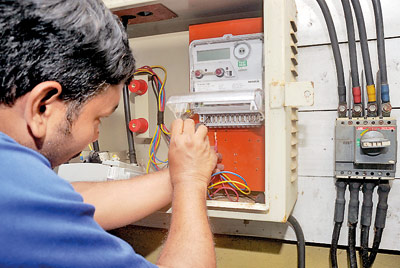News
CEB expands digital/electronic meter installation into household sector
View(s): The Ceylon Electricity Board (CEB) is expanding the installation of digital or electronic meters to the household sector, officials said.
The Ceylon Electricity Board (CEB) is expanding the installation of digital or electronic meters to the household sector, officials said.
“These meters were first introduced in 2011 to general purpose and bulk customers, but are now available to three-phase domestic customers at an installation fee of Rs 8,700,” said Additional General Manager (Corporate Strategy) Bandula S. Tilakasena.
He explained that these were not the same as “smart meters” which have more sophisticated features—such as two-way communication with a control centre—than those the CEB was currently installing.
“Such meters are still not in place as they are very expensive equipment,” he explained. “We have a manufacturing subsidiary under LECO (Lanka Electricity Company) which is making them, but we have not planned for all customers to receive them in the near future.”
What is being installed now, however, is an electronic meter to replace the old rotating disc meters currently in use. “General purpose and bulk customers have them from 2011,” Mr Tilakasena explained. “These are not capable of two-way communication, but it is possible for the control centre to get the meter reading remotely.”
Users of the new meter can also benefit from the “time of use tariff”. The meter is programmed to distinguish between three bands of tariffs—daytime, peak and off-peak.

The fact that a control centre can access the meter remotely makes the billing process easier. It precludes manual reading of the meter as is done at present. Pic by Amila Gamage
This enables users to postpone some heavy duty tasks such as charging their electric cars or operating the washing machine to off-peak hours, and be billed accordingly.
“The advent of electric cars is one of the main reasons we have accelerated this programme,” said Mr Tilakasena. “The hindrance for getting it to all customers is the cost of the meter.
But our meter subsidiary is going to have a single-phase meter capable of time of use tariff. LECO will produce this and make it available tosingle-phase customers as well.”
The fact that a control centre can access the meter remotely makes the billing process easier. It precludes manual reading of the meter as is done at present.
“This has been happening for large customers for the last two or three years,” Mr Tilakasena said. “Some have been getting email bills. Also, historical data is available.”
In terms of the three time bands, a flat rate is charged between 6.30 am and 4.30 pm (day rate), a higher rate is charged from 5.30 pm to 10.30 pm (peak) and off-peak brings with it a lower rate than both those bands.
The rotating disc meters now in use charge customers at a single rate, not three, irrespective of time.

